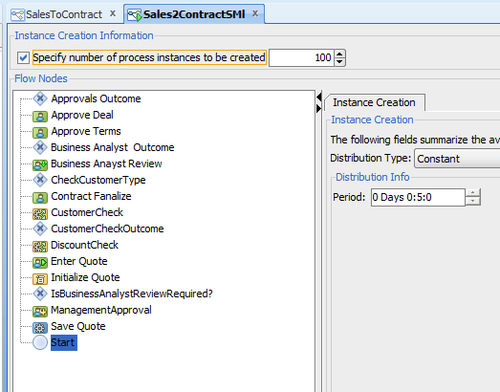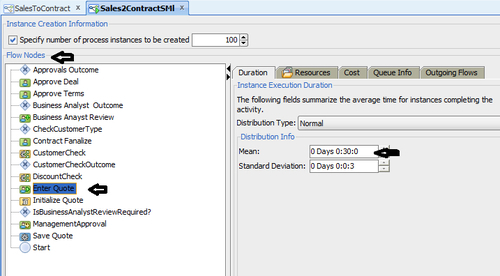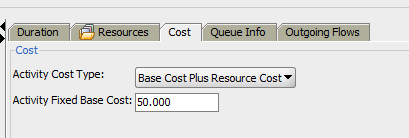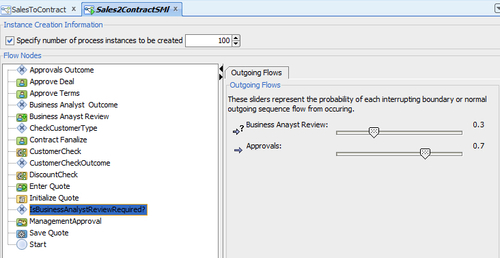The simulation model you are going to create would be a 'what-if' sort of experiment of the process that you will perform before it goes live into production. With the outcome of simulation results, you can analyze the different bottlenecks and can perform certain measures to reduce process cost to the business.
With a process simulation model, you can configure process settings. You will first create a table specifying what the process settings for different activities of the SalesToContract process would be.
Duration defines the time an activity takes to complete. It defines the distribution type, say constant, uniform, exponential, normal, and real. You will use normal distribution, which uses Gauss Bell distribution. This determines how long an activity takes to complete. You have to enter mean period and standard deviation when prompted.
Cost specifies the cost of processing the activity. For User tasks, it also specifies the cost of the resources assigned to the User task. Cost could be fixed base cost or fixed base cost with resource cost added into it. This is calculated based on the defined cost per hour and the time it takes for the resource to execute that task. Generally, this is enabled for User task.
Resources specify the number of participants assigned to a particular role. You can define this parameter in the simulation model or at a global project level in the project simulation definition.
Queue defines the simulated behavior of how process instances are queued for a given activity. It defines the Queue Size, which is the number of instances that can wait for an activity simultaneously, and Queue Info, which enables you to configure the simulated behavior of how the process instances are picked from the queue FICO, LIFO, by priority, or randomly.
Sequence flows determine the probability percentage of instances routed through the different outgoing sequence flows. Move the slider to specify the probability of occurrence of each outgoing sequence flow.
In this section, you will define a simulation model:
- Go to JDeveloper | BPM Project Navigator and expand the SalesToContractDemo project.
- Click on Processes | SalesToContract.
- Go to the Simulations node and expand it.
- You will find two stores to store Simulation Models and its definition.
- Select the Simulation Model folder, right-click it, and select New Process Simulation Model.
- In the Create Process Simulation dialog, enter
SalesToContractSMas Model name.
- Click OK.
- This will open the Sales2ContractSM simulation model.
- Enter number of process instances to be created as
100, as you assume that 100 Quote requests will get generated on every working day. - In the simulation model, go to Start Activity and select Constant as the Distribution Type.
- You are doing this to configure the frequency of process instances created.
- Enter
5minutes as the frequency of process instance creation.
- Click Enter Quote in the Flow Nodes list in the simulation model, and in the Duration tab, enter values as follows:
- Distribution Type: Normal
- Mean: 30 minutes
- Standard Deviation: 3 seconds

- Click on the Resources tab and enter the following values:
- Check: Use Fixed Resources
- Value: 1
- Select the Cost tab and enter values, as shown in the following screenshot:

- Click on the Queue Info tab and enter 2 as Warning Size.
- Click the IsBusinessAnalystReviewRequired? activity, and in the Outgoing Flows tab, set values as shown in the following screenshot:

- You will assume that 30 percent (.3 probability) of cases go for Business Analyst Review and 70 percent of the cases move ahead for Approvals.
- You can similarly use the following table to enter values for other activities as well.
- You will use the following table to enter values for activity parameters such as Duration, Resource, Cost, Queue, and Flow.
Activity
Duration
Resources
Cost
Queue
Flow
Initialize Quote
Normal-10 sec, 3 sec
-
Fixed - $0
1
-
Enter Quote
Normal-30 min, 3 sec
5
Fixed + Resource
- $50
2
-
CustomerCheck
Normal- 3 sec, 3 sec
-
Fixed - $0
1
-
CheckCustomer Type
Management Approval Flow - 0.2
DiscountCheck - 0.8
(You can assume that the probability of a 'New' Customer is 0.2.)
Management Approval
Normal- 30 min, 3 sec
6
Fixed + Resource
- $300
1
-
CustomerCheck Outcome
Enter Quote - 0.2
DiscountCheck - 0.8
(Assuming only 20 percent of the cases go back for Reviews.)
DiscountCheck
Normal- 3 sec, 3 sec
-
Fixed - $0
1
-
IsBusinessAnalyst ReviewRequired
Business AnalystReview - 0.3
Approvers - 0.7
(Assuming 30 percent of the cases need Business Analyst Review)
BusinessAnalyst Review
Normal- 30 min, 3 sec
2
Fixed + Resource
- $100
-
BusinessAnalyst Outcome
EnterQuote - 0.3
Approvals - 0.7
(Assuming only 30 percent get rejected.)
ApproveDeal
Normal- 10 min, 3 sec
1
Fixed + Resource
- $50
ApproveTerms
Normal- 10 min, 3 sec
1
Fixed + Resource
- $50
-
-
ApproversOutcome
-
-
-
-
EnterQuote - 0.3
Finalize Contract - .7
(Assuming 70 percent of the quotes move for finalization.)
Contract Finalize
Normal- 20 min, 3 sec
1
Fixed + Resource
- $100
Save Quote
Normal- 5 min, 3 sec
1
Fixed + Resource
- $50
You have assumed that this is the Cost meant for 1 day for the process.
- When you have finished, click Save.
- Close the Simulation Model tab.
Simulation models allow you to simulate the behavior of an individual process. Here, you have defined the activities parameters. They enable you to define how a process behaves as part of a simulation definition. You can define multiple simulation models for each process, creating different simulations based on different combinations of resource allocation and activity behavior.
